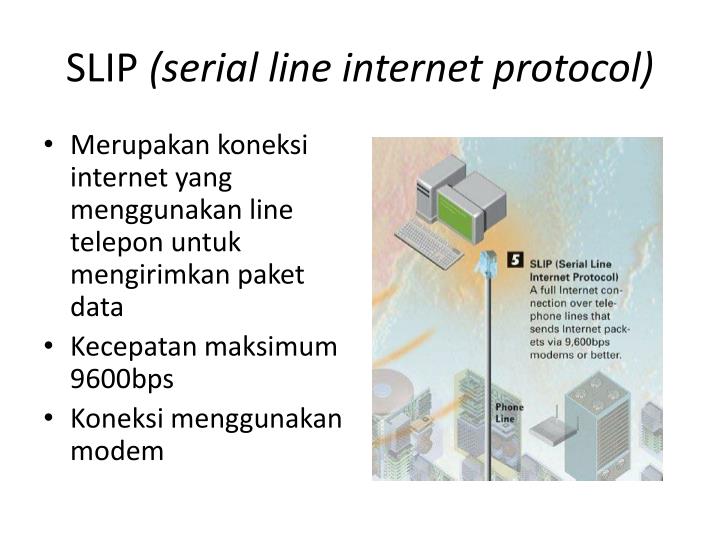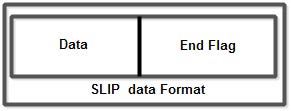Serial Line Internet Protocol
Serial module in slot 0 and serial module in slot 1; The features supported by the single-port serial module on Cisco 800M Series ISR is given as follows: Supports the following encapsulations: – HDLC – PPP – Frame Relay – Serial Line Internet Protocol (SLIP) Supports the following serial protocols – EIA-232 – EIA-449 – EIA-530. Serial Line Internet Protocol (SLIP) (Page 1 of 3) The need for a data link layer protocol to let IP operate over serial links was identified very early on in the development of TCP/IP. Engineers working on the Internet Protocol needed a way to send IP datagrams over serial connections linking computers together.
- Serial Line Internet Protocol (SLIP) can provide TCP/IP hosts with dial-up access to the Internet by using SLIP servers located at Internet service providers (ISPs). SLIP – Serial Line Internet Protocol. SLIP is an older serial line protocol that doesn’t support automatic negotiation of network configurations.
- Definition of Serial Line Internet Protocol (SLIP) in Network Encyclopedia. What is SLIP (Serial Line Internet Protocol)? SLIP is an industry-standard protocol developed in 1984 for UNIX environments that supports TCP/IP networking over serial transmission lines. These serial lines are typically dial-up connections using a modem.
Definition
 NetworkInterfaceType
NetworkInterfaceTypeFields
| AsymmetricDslAsymmetricDslAsymmetricDslAsymmetricDsl | 94 | The network interface uses an Asymmetric Digital Subscriber Line (ADSL). |
| AtmAtmAtmAtm | 37 | The network interface uses asynchronous transfer mode (ATM) for data transmission. |
| BasicIsdnBasicIsdnBasicIsdnBasicIsdn | 20 | The network interface uses a basic rate interface Integrated Services Digital Network (ISDN) connection. ISDN is a set of standards for data transmission over telephone lines. |
| EthernetEthernetEthernetEthernet | 6 | The network interface uses an Ethernet connection. Ethernet is defined in IEEE standard 802.3. Simulation of changing light conditions. Dynamic sky with light scattering. Download windows 8. Interactive experience with fly/walk-through modes. |
| Ethernet3MegabitEthernet3MegabitEthernet3MegabitEthernet3Megabit | 26 | The network interface uses an Ethernet 3 megabit/second connection. This version of Ethernet is defined in IETF RFC 895. |
| FastEthernetFxFastEthernetFxFastEthernetFxFastEthernetFx | 69 | The network interface uses a Fast Ethernet connection over optical fiber and provides a data rate of 100 megabits per second. This type of connection is also known as 100Base-FX. |
| FastEthernetTFastEthernetTFastEthernetTFastEthernetT | 62 | The network interface uses a Fast Ethernet connection over twisted pair and provides a data rate of 100 megabits per second. This type of connection is also known as 100Base-T. |
| FddiFddiFddiFddi | 15 | The network interface uses a Fiber Distributed Data Interface (FDDI) connection. FDDI is a set of standards for data transmission on fiber optic lines in a local area network. |
| GenericModemGenericModemGenericModemGenericModem | 48 | The network interface uses a modem. |
| GigabitEthernetGigabitEthernetGigabitEthernetGigabitEthernet | 117 | The network interface uses a gigabit Ethernet connection and provides a data rate of 1,000 megabits per second (1 gigabit per second). |
| HighPerformanceSerialBusHighPerformanceSerialBusHighPerformanceSerialBusHighPerformanceSerialBus | 144 | The network interface uses a High Performance Serial Bus. |
| IPOverAtmIPOverAtmIPOverAtmIPOverAtm | 114 | The network interface uses the Internet Protocol (IP) in combination with asynchronous transfer mode (ATM) for data transmission. |
| IsdnIsdnIsdnIsdn | 63 | The network interface uses a connection configured for ISDN and the X.25 protocol. X.25 allows computers on public networks to communicate using an intermediary computer. |
| LoopbackLoopbackLoopbackLoopback | 24 | The network interface is a loopback adapter. Such interfaces are often used for testing; no traffic is sent over the wire. |
| MultiRateSymmetricDslMultiRateSymmetricDslMultiRateSymmetricDslMultiRateSymmetricDsl | 143 | The network interface uses a Multirate Digital Subscriber Line. |
| PppPppPppPpp | 23 | The network interface uses a Point-To-Point protocol (PPP) connection. PPP is a protocol for data transmission using a serial device. |
| PrimaryIsdnPrimaryIsdnPrimaryIsdnPrimaryIsdn | 21 | The network interface uses a primary rate interface Integrated Services Digital Network (ISDN) connection. ISDN is a set of standards for data transmission over telephone lines. Barcode scanner for macbook pro. |
| RateAdaptDslRateAdaptDslRateAdaptDslRateAdaptDsl | 95 | The network interface uses a Rate Adaptive Digital Subscriber Line (RADSL). |
| SlipSlipSlipSlip | 28 | The network interface uses a Serial Line Internet Protocol (SLIP) connection. SLIP is defined in IETF RFC 1055. |
| SymmetricDslSymmetricDslSymmetricDslSymmetricDsl | 96 | The network interface uses a Symmetric Digital Subscriber Line (SDSL). |
| TokenRingTokenRingTokenRingTokenRing | 9 | The network interface uses a Token-Ring connection. Token-Ring is defined in IEEE standard 802.5. |
| TunnelTunnelTunnelTunnel | 131 | The network interface uses a tunnel connection. |
| UnknownUnknownUnknownUnknown | 1 | The interface type is not known. |
| VeryHighSpeedDslVeryHighSpeedDslVeryHighSpeedDslVeryHighSpeedDsl | 97 | The network interface uses a Very High Data Rate Digital Subscriber Line (VDSL). |
| Wireless80211Wireless80211Wireless80211Wireless80211 | 71 | The network interface uses a wireless LAN connection (IEEE 802.11 standard). |
| WmanWmanWmanWman | 237 | The network interface uses a mobile broadband interface for WiMax devices. |
| WwanppWwanppWwanppWwanpp | 243 | The network interface uses a mobile broadband interface for GSM-based devices. |
| Wwanpp2Wwanpp2Wwanpp2Wwanpp2 | 244 | The network interface uses a mobile broadband interface for CDMA-based devices. |
Serial Line Internet Protocol Example
Remarks

Serial Line Internet Protocol Pdf
Network interfaces, also known as network adapters, connect a computer to a network. The interface type defines the transmission media that provides network connectivity.
This enumeration defines the values returned by the NetworkInterface.NetworkInterfaceType property.